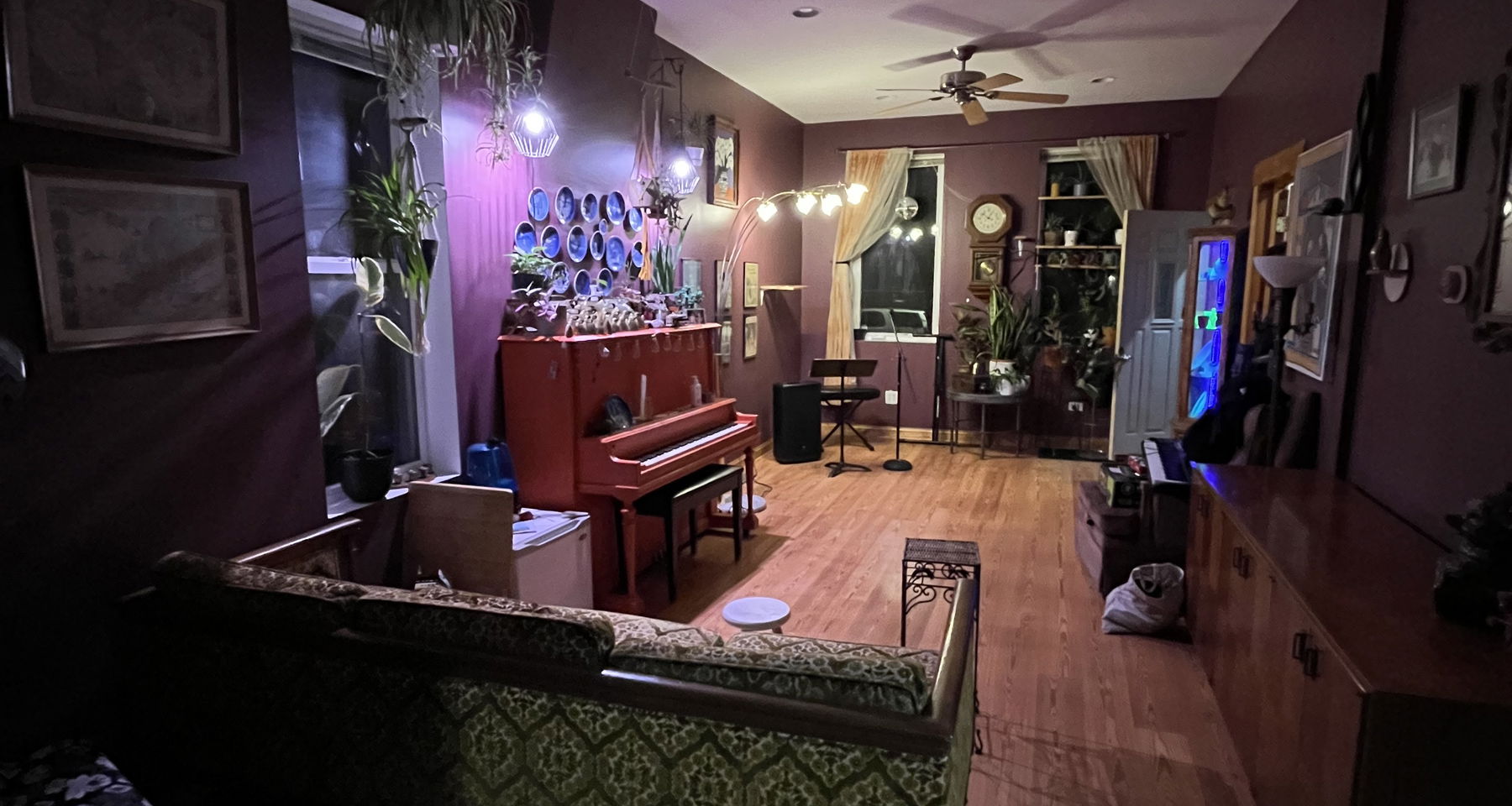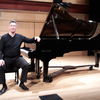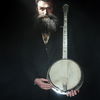
Aaron Jonah Lewis & Hope Arthur Ragtime Banjo & Piano Concert
Humboldt Park, Chicago
Sat, April 5, 2025, at 7:45 PM,
CDT

- Bring your own drinks
-

- Cats live here
-
Wheelchair access
- Not wheelchair accessible
-
- Some stairs may be present in the space
-
- Kid-friendly event
This is a groupmuse
A live concert in a living room, backyard, or another intimate space. They're casual and friendly, hosted by community members.
Host
The Spaceship is launching once again with a fantastic evening of early American ragtime music featuring solo sets from Aaron Jonah Lewis (banjo, fiddle, and voice) and Hope Arthur (piano, accordion, and voice). At the end of the evening, Aaron and Hope will combine forces for one last set with a special tuba guest!
You are welcome to bring your own food and beverages to the Spaceship - glassware will be available for your use. There will be some seating available as well as floor/standing room space.
What's the music?
Beaver Slide Rag - Peg Leg Howell & Eddie Anthony (1927)
We love to start with this piece as it grabs the attention and says "Hey! We're here to have a good time!" It's also nice to start not at the beginning and move forwards and backwards in time. This is sort of a ragtime country blues fiddle piece that shows the influence and represents a confluence of those different genres in an underrepresented Black American folk tradition.
Pearl of the Harem - Harry P. Guy (1870-1950)
Harry P. Guy attended the National Conservatory of Music in New York where the famed operetta and popular song composer and cellist Victor Herbert was one of his professors. Harry became heavily involved in Black musical affairs in New York, opening his own piano teaching studio, and even appearing once on stage at Carnegie Hall among other concerts. He moved to Detroit in 1895, where he would stay the rest of his life. In the pre-motor age Detroit was one of the major stops on both the vaudeville and theater circuits, so there was a lot of fresh musical activity in both Black and white venues. He quickly became involved with the Black musical community in Detroit, eventually becoming a founding member of Fred S. Stone's Black musicians union. One of Guy's earliest publications in Detroit was his often recorded Echoes from the Snowball Club from 1898, named after his own early musicians union and colored social club, and considered to be the first "rag-time waltz". Pearl of the Harem followed in 1901 and became a popular ragtime intermezzo and favorite of banjo player Fred Van Eps, who first recorded the piece in 1911.
Maple Leaf Rag - Scott Joplin (1868–1917)
Scott Joplin was an American composer and pianist. Dubbed the "King of Ragtime,” he composed more than 40 ragtime pieces, one ragtime ballet, and two operas. One of his first and most popular pieces, the "Maple Leaf Rag", became the genre's first and most influential hit, later being recognized as the quintessential rag. Joplin considered ragtime to be a form of classical music meant to be played in concert halls and largely disdained the performance of ragtime as honky tonk music most common in saloons.
Raggin' the Scale - Eubie Blake (1887-1983) & Hughie Wolford
James Hubert "Eubie" Blake was an American pianist and composer of ragtime, jazz, and popular music. In 1921, he and his long-time collaborator Noble Sissle wrote Shuffle Along, one of the first Broadway musicals written and directed by African Americans. Not much is known about Hughie Wolford other than that he was a contemporary of Blake's in the early Boston ragtime scene. "Raggin' the Scale" was co-written by Blake and Wolford and copyrighted about a decade later by white composer Ed Claypoole. Years later Eubie lamented, "I never thought to copyright it or anything... I'd have felt foolish tryin' to copyright the scale."
A Banjo Frolic - Joe Morley (1867-1937)
Joe Morley was a British classic banjoist who achieved great fame and renown in his homeland and abroad. During his lifetime, he composed hundreds of banjo solos. Although this piece is from 1932, after the peak of classic banjo's popularity, it's worth noting that classic banjo music preceded and influenced the development of ragtime and was the most popular style of music in the English-speaking world from the mid-19th century into the early 20th.
Frog Legs Rag - James Scott (1885-1938)
James Sylvester Scott was an American ragtime composer and pianist. He is regarded as one of the "Big Three" composers of classical ragtime along with Scott Joplin and Joseph Lamb. In 1905 Scott went to St. Louis, Missouri, in search of his idol Scott Joplin. He located Joplin and asked if he would listen to one of his ragtime compositions. Upon hearing the rag, Joplin introduced him to his own publisher, John Stillwell Stark, and recommended he publish the work. Stark published the rag a year later in 1906 as "Frog Legs Rag". It quickly became a hit and was second in sales in the Stark catalogue only to that of Joplin's own "Maple Leaf Rag". Scott became a regular contributor to the Stark catalogue until 1922. Scott's best-known compositions include "Climax Rag", '"Frog Legs Rag", "Grace and Beauty", "Ophelia Rag", and "The Ragtime Oriole".
Sunflower Slow Drag - Scott Joplin (1868–1917) and Scott Hayden (1882-1915)
While Joplin's name was given top billing, scholars Jasen and Tichenor assert that everything except the trio was primarily Hayden's work. The trio, attributed to Joplin, is distinguished by its softer dynamics, pentatonic emphasis, and broader range. The copyright was registered March 18, 1901. The piece was originally published by John Stillwell Stark, who advertised it as "the twin sister of Maple Leaf”. Stark also reported that the trio was written during Joplin's courtship of Belle Hayden, his first wife, who was also Scott Hayden's sister-in-law, his brother's widow. Sunflower Slow Drag has been described as “full of gaiety and sunshine.”
Carnival - Tarrant Bailey, Jr. (1907-1987)
Tarrant Bailey Junior was probably the greatest and most prolific recording and broadcasting star in the UK of the 1920s to the 1940s. He was the finest exponent of both fingerstyle and plectrum playing.
The plectrum banjo had come to dominate the jazz bands and apart from the BBC's 'Kentucky Minstrels Show' featuring Tarrant Bailey Jnr., Joe Morley and Dick Pepper, there were fewer and fewer broadcasting or recording opportunities for the Classic style players of the time. The 'old style' of banjo playing had fallen out of favour with the buying public too and, from 1933 to 1942, the only commercial fingerstyle recordings released by the major record labels were of Tarrant Bailey Jnr. Carnival was composed by Bailey in 1945.
A Footlight Favourite - Emile Grimshaw (1880-1943)
We’ll close out the evening with a rollicking romp of a piece, replete with dramatic moments evocative of early silent films. (Picture someone in distress tied to railroad tracks, a sinister villain grinning, and a hero upon a white horse who cries, “I’ll save you!”) Emile Grimshaw (1880 to 1943) was born in Accrington, Lancashire, in the North of England. Grimshaw was an avid player of, and composer for, the banjo though his first composition was arranged for mandolin and was published around 1895. He later became a music teacher, offering both banjo and mandolin instruction and also ran the local BMG orchestra that was based in the nearby town of Burnley. In addition to his teaching work he was kept busy composing music for the banjo, mandolin and guitar.
Where does this music come from?
“When you want a real syncopated rag, well done with plenty of gravy, have it served hot on a banjo.” — Thomas Armstrong (1859-1932)
For decades around the turn of the 20th century classic finger-style banjo was the most popular kind of music in the English-speaking world, although today it is all but forgotten. This music comes from African-American music that was appropriated for minstrel shows and mingled with other popular styles of European and distinctly American origin. It gave rise to ragtime (for example, both of Scott Joplin’s parents played three-finger banjo), which fed into the development of jazz. Classic banjo is a bridge between the banjo of minstrel shows and the banjo of early jazz and country music.
Ragtime music represents the first music and dance movement of free Black people in the US. Its composers intended to create a music that would entertain and elevate, a music both lighthearted and dignified that could respond to Western European traditions and form a foundation for American popular and art music to come. Ragtime also represents the pinnacle of popular music before the widespread adoption of audio recording technology. These were the last days that the only way a person could hear music was by being within earshot of someone playing or singing, or by creating music themselves.
Our primary interest and challenge in this project is to find ways to make a near-dead form of music compelling and engaging in an environment where many people regard looking to the past as out-of-touch or moving backward. For us this music provides a missing link in our shared cultural history. It opens doors to discussion and understanding of how we got to where we are now and it's remarkably accessible and easy to enjoy.
Location
Exact address sent to approved attendees via email.
This is a groupmuse
A live concert in a living room, backyard, or another intimate space. They're casual and friendly, hosted by community members.
Host
Attendees








 Continue with Facebook
Continue with Facebook
 Continue with Google
Continue with Google
 Continue with Apple
Continue with Apple
Comments
Comment sections are only for participants.